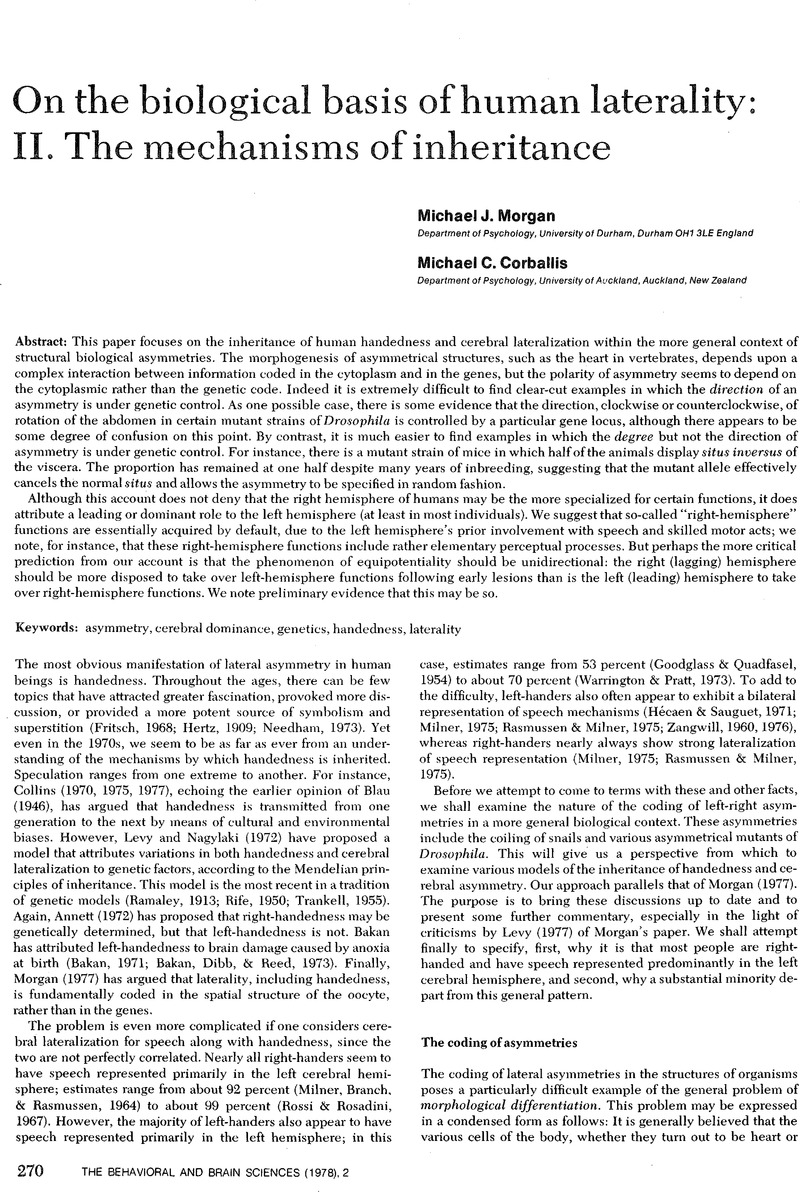Crossref Citations
This article has been cited by the following publications. This list is generated based on data provided by Crossref.
Porac, Clare
and
Coren, Stanley
1979.
A Test of the Validity of Offsprings' Report of Parental Handedness.
Perceptual and Motor Skills,
Vol. 49,
Issue. 1,
p.
227.
Porac, Clare
Coren, Stanley
and
Duncan, Pam
1980.
Lateral preference in retardates: Relationships between hand, eye, foot, and ear preference.
Journal of Clinical Neuropsychology,
Vol. 2,
Issue. 3,
p.
173.
McManus, I.C.
1980.
Handedness in twins: A critical review.
Neuropsychologia,
Vol. 18,
Issue. 3,
p.
347.
McManus, I.C.
1980.
Left-Handedness and Epilepsy.
Cortex,
Vol. 16,
Issue. 3,
p.
487.
Coren, Stanley
and
Porac, Clare
1980.
Birth factors and laterality: Effects of birth order, parental age, and birth stress on four indices of lateral preference.
Behavior Genetics,
Vol. 10,
Issue. 2,
p.
123.
BOKLAGE, CHARLES E.
1980.
Neuropsychology of Left-Handedness.
p.
115.
Perelle, Ira B.
Ehrman, Lee
and
Manowitz, J. W.
1981.
Human Handedness: The Influence of Learning.
Perceptual and Motor Skills,
Vol. 53,
Issue. 3,
p.
967.
McManus, I. C.
1981.
Handedness and birth stress.
Psychological Medicine,
Vol. 11,
Issue. 3,
p.
485.
Ehrlichman, Howard
Zoccolotti, Pierluigi
and
Owen, David
1982.
Perinatal factors in hand and eye preference: Data from the collaborative perinatal project.
International Journal of Neuroscience,
Vol. 17,
Issue. 1,
p.
17.
Ashton, Geoffrey C.
1982.
Handedness: An alternative hypothesis.
Behavior Genetics,
Vol. 12,
Issue. 2,
p.
125.
McManus, I.C.
1983.
Pathologic left-handedness: Does it exist?.
Journal of Communication Disorders,
Vol. 16,
Issue. 5,
p.
315.
1983.
Human Laterality.
p.
203.
Perelle, Ira B.
and
Ehrman, Lee
1983.
The development of laterality.
Behavioral Science,
Vol. 28,
Issue. 4,
p.
284.
Fride, Ester
and
Weinstock, Marta
1987.
Increased interhemispheric coupling of the dopamine systems induced by prenatal stress.
Brain Research Bulletin,
Vol. 18,
Issue. 3,
p.
457.
Ross, Gail
Lipper, Evelyn G.
and
Auld, Peter A. M.
1987.
Hand Preference Of Four‐Year‐Old Children: Its Relationship To Premature Birth And Neurodevelopmental Outcome.
Developmental Medicine & Child Neurology,
Vol. 29,
Issue. 5,
p.
615.
Bakan, Paul
1990.
Vol. 67,
Issue. ,
p.
33.
Bakan, Paul
1991.
Handedness and maternal smoking during pregnancy.
International Journal of Neuroscience,
Vol. 56,
Issue. 1-4,
p.
161.
Ross, Gail
Lipper, Evelyn
and
Auld, Peter A.M.
1992.
Hand preference, prematurity and developmental outcome at school age.
Neuropsychologia,
Vol. 30,
Issue. 5,
p.
483.
Saigal, Saroj
Rosenbaum, Peter
Szatmari, Peter
and
Hoult, Lorraine
1992.
NON‐RIGHT HANDEDNESS AMONG ELBW AND TERM CHILDREN AT EIGHT YEARS IN RELATION TO COGNITIVE FUNCTION AND SCHOOL PERFORMANCE.
Developmental Medicine & Child Neurology,
Vol. 34,
Issue. 5,
p.
425.
Tan, Üner
and
Zor, Nevin
1994.
Grasp-Reflex Strength from Right and Left Hands in Relation to Serum Cortisol Level and Fetal Position in Human Neonates.
International Journal of Neuroscience,
Vol. 74,
Issue. 1-4,
p.
27.



